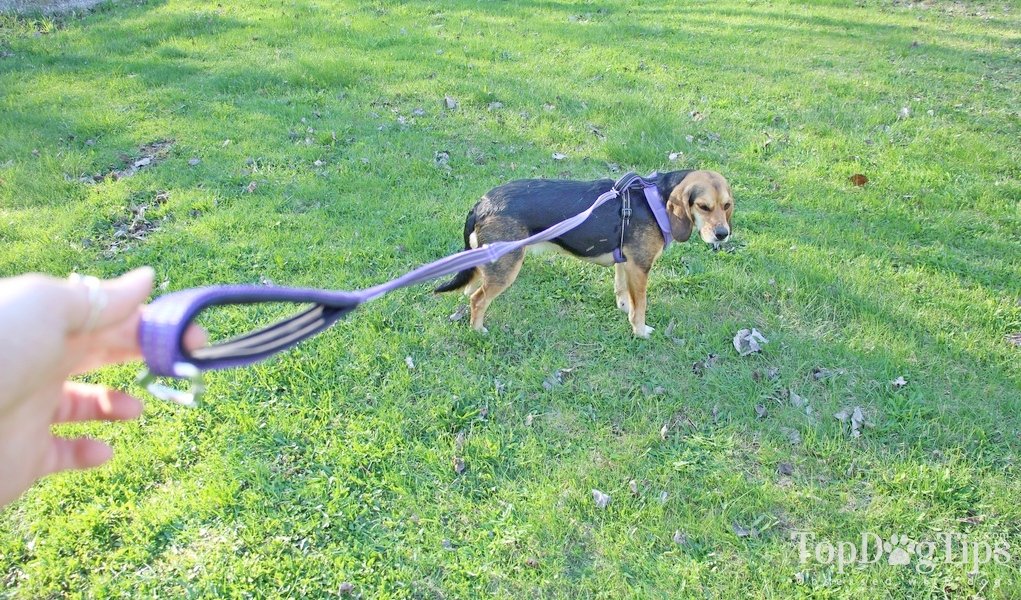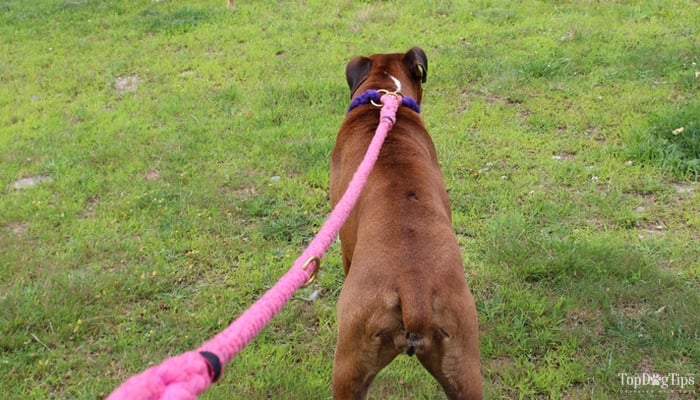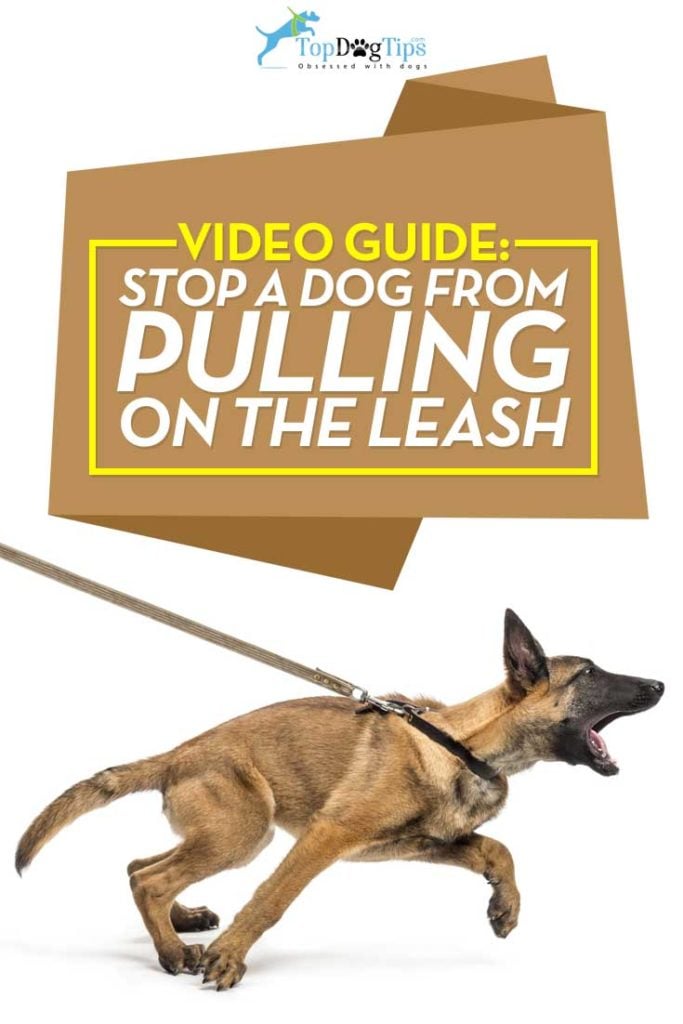Table of Contents
A pulling dog is not only annoying but also dangerous.
The dog can not only hurt himself. He's also likely to damage your arm, shoulder, and back.
Learning how to stop a dog from pulling will take a bit of time, but it's one of the essential training parts.
But why do dogs do this?
When training, walking, or playing with your dog, dogs tend to follow their instincts and do what works for them.
Therefore, if your dog pulls on a leash and you follow him to where he wants to go, he will continue to pull because he thinks that it will get him to where he wants to go.
Countering this dog logic will be the basis for learning how to stop dogs from pulling.
While some pull occasionally and mildly, other dogs pull often and hard.
Experts recommend switching to a no-pull dog harness instead of a regular leash and collar combo for training and future walks.
In this article and the above video, I'll give you a few tips on how to deal with dog leash pulling and stop your pet from doing that.

How to Stop a Dog from Pulling on Leash
1. Understand Why Your Dog Is Pulling
Most dog training is lengthy and may incorporate some complex steps.
It's best to start off slowly and increase the training gradually.
Fortunately, teaching your dog to stop pulling on a leash can actually be very simple, but it requires time and patience.
The first thing you'll need to do is understand why your dog is pulling.
This will determine whether you can fix the problem yourself or not.
For example, if you have a hyperactive dog that simply gets overly excited when out for a walk and is very enthusiastic about exploring, then you can prevent leash pulling by yourself during these walks.
However, if your dog becomes aggressive when on a leash (and only when on a leash), then you should consider working with a professional dog trainer to avoid trouble.
Leash aggression is dangerous behavior. It's also fairly common and easy to spot.
So if your pet is generally well-tempered when off the leash yet turns into Cujo the second you hook up his lead, it's a clear sign of leash aggression and must be addressed.
Upstate Canine Academy did a great video on this subject.
2. Learn the 5 Steps to Stop a Dog from Pulling on the Leash
The concept is quite simple. Your Fido pulls on his lead to get what he wants.
For example, he wants to sniff a different area, see a dog that's across the park, catch that squirrel, or just explore in a different direction.
He pulls because he thinks it will get him what he wants.
To stop your dog from pulling means you cannot give the dog what he wants.
(1) Prepare to stop. When your dog begins to pull on the leash this way, you need to stop in place. Do not follow him, and you also cannot let him drag you even a few feet before you stop.
(2) Feel the trigger. Now, you know he's going to pull at some point, so as soon as the leash is pulled tight by your dog and you feel pressure on your hand, stop.
(3) Wait. You need to avoid movement and let your dog release the tension on the leash so as not to hurt your pooch. When you feel slack on the leash, move on.
(4) Turn around. After that, to show the dog that pulling doesn't get him what he wants, turn around and walk in a different direction.
(5) Repeat it. Do the same thing whenever the leash is pulled. You need to do this every single time because if he gets away with pulling sometimes, even once in a while, he will continue to think that it will get him what he wants.
Sometimes, you may need to call your dog to come over to you after you stop him.
Whenever you do this and call him with a command, or your pet walks back to you on his own, always praise him and show the dog some affection.
Showing your pooch that he will not get what he wants by pulling on his leash and then rewarding him for coming back near you (doing the right thing) will show the dog what he is expected to do when on the leash.
This will take some time, but most dogs will eventually learn it.
3. Choose the Right Environment for Training
When you're first beginning with dog leash-pulling training, you may need to start indoors, especially if your dog gets way too excited the second you head for the door.
Then, when your dog learns to control the urge to pull inside, take him outdoors.
At first, you also need to remove all distractions and start with baby steps.
The backyard is an even better option. Begin in your own yard with minimal distractions.
Once your dog can walk nicely without pulling, bring out other family members or pets that will entice your pup to pull (deliberate distraction).
Continue showing your pet that pulling on the leash will not get him what he wants and if he follows distractions.
It's likely that the dog will still try to pull when something is extremely exciting to them.
For example, the first few times you bring your Fido to a public place like a dog park, there will probably be too much excitement for him to bear.
Fortunately, most dogs get used to managing their excitement and eventually learn what you need from them.
Consistency is key.
No matter where you are or how short you are on time, you need to stop the dog from pulling as soon as you feel lead tension.
4. Get a No-Pull Harness for Leash-Pulling Training
Whether your dog is strong or not, small or big, there's always a chance they may hurt themselves if they get distracted and pull heavily on the leash.
To prevent this, it's recommended to avoid using collars (at least during training) and switch to no-pull harnesses, which are much safer for hyperactive and overly excited dogs.
5. Read Dog Training Books for More Tips
The above short guide on dog leash pulling is simple and straightforward; however, if you're still having trouble with teaching yourself how not to pull on your leash, you might want to read some more detailed guides.
There are many training books you can try, and most of them have useful advice, step-by-step instructions with pictures, and tips for the most common training issues.
My personal favorite is 101 Dog Tricks – it's simple and doesn't over-complicate things.
 Other good dog training books you should try are these:
Other good dog training books you should try are these:
- Team Dog: The Navy SEAL Way by Mike Ritland
- Training the Best Dog Ever by Larry Kay
- Zak George's Dog Training Revolution by Zak George
- Lucky Dog Lessons by Brandon McMillan
Most of these dog training books are written by respected dog trainers, so you know you're in good hands.
All of them contain detailed guides, additional tips, and plenty of photos to illustrate the point the author is making.
FAQs about Dog Leash-Pulling
Why do dogs like pulling?
Dogs like pulling for a variety of reasons, including instinct, excitement, reinforcement, and lack of training.
Pulling can be a natural behavior for dogs, related to their ancestry as working and hunting animals, and can be a way for them to exert energy and engage in physical activity.
Is it good for dogs to pull?
While pulling may be a natural behavior for dogs, it is not necessarily good for them to pull on a leash.
Pulling can cause discomfort or injury to the dog or their owner and can make walks less enjoyable for both parties.
Additionally, excessive pulling can be a sign of a lack of training or poor behavior, which can lead to other issues, such as aggression or anxiety.
How do you break bad leash habits?
Breaking bad leash habits in dogs requires patience, consistency, and positive reinforcement.
Here are some of the things you can do:
1. Train alternative behavior: Train your dog to engage in an alternative behavior, such as walking calmly or sitting.
2. Use positive reinforcement: Reward Fido for engaging in the desired behavior using positive reinforcement techniques such as treats or praise.
3. Be consistent: Consistency is key when breaking bad leash habits. It's important to be consistent in training and to reinforce the desired behavior every time it is exhibited.
4. Use tools: Tools such as a front-clip harness or a head collar can be helpful in reducing pulling and making walks more enjoyable for both the dog and their owner.
5. Seek professional help: If the bad leash habits persist or are causing problems, it may be helpful to seek the assistance of a professional dog trainer or behaviorist.
How long does it take to train a dog to stop pulling?
The time it takes to train a dog to stop pulling on a leash can vary depending on the dog's age, breed, temperament, and previous training.
Some dogs may learn quickly and respond well to positive reinforcement techniques, while others may require more time and effort.
Generally, it can take several weeks to several months of consistent training to see significant improvement in a dog's pulling behavior.
It's important to be patient and consistent in training and to reinforce the desired behavior every time it is exhibited.
How to Stop a Dog from Pulling on Leash: Before You Go…
Remember that mitigating this behavior as soon as you've noticed it is important to avoid any harmful or dangerous situation from happening.
While pulling is part of a dog's natural instinct, it doesn't mean you have just to let them do it.
In fact, it's best to redirect their attention and energy to other safe and worthwhile activities, like playing.
Does your dog pull on his leash too? What did you do to train them out of it?
Share with us your thoughts in the comments section!
If you're interested in reading more about this behavior, you can check out our recommended articles below!
Related Articles:
- 6 Dangers of Dogs Pulling on Leash (And What You Must Do)
- How to Train a Dog to Walk on a Leash
- Why No-Pull Dog Harnesses Are the Safest Choice
Disclosure: We may earn affiliate commissions at no cost to you from the links on this page. This did not affect our assessment of products. Read more here and find full disclosure here.



















